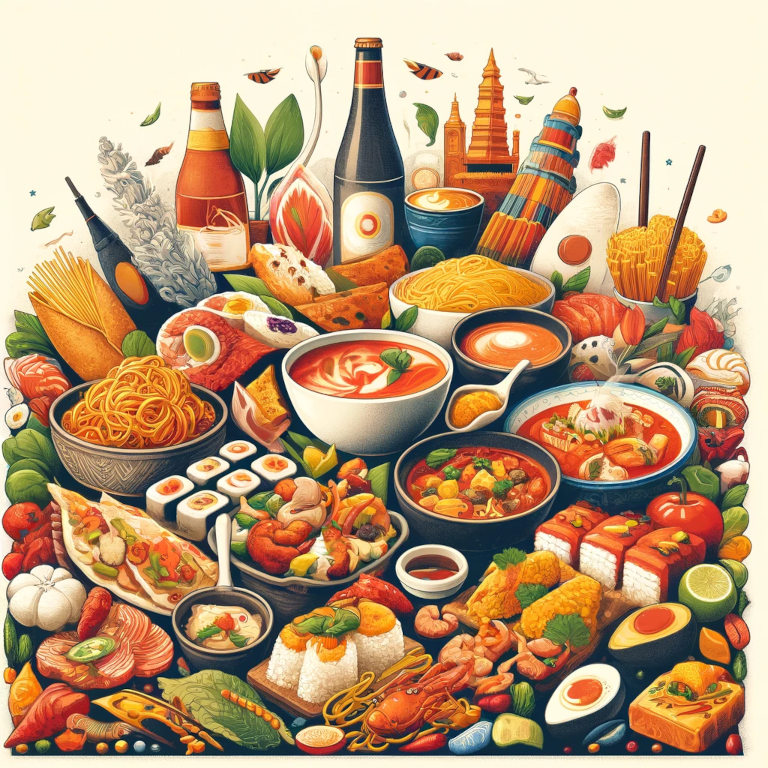Culinary curiosity is more than just a penchant for good eating; it’s a gateway to the world’s cultures, histories, and traditions. As an expert in food and cooking, I invite you to embark on an exploration of international cuisines that not only tantalize the taste buds but also enrich our understanding of global communities. This guide will delve into the diverse world of international cuisines, highlighting how they can transform ordinary dining into an extraordinary journey of discovery.
The Essence of International Cuisines
International cuisines provide a palpable insight into the cultures from which they originate. Each dish tells a story, whether it’s through the spices used, the methods of cooking, or the traditions that accompany its preparation and consumption. Exploring these cuisines offers a taste of the world, without ever leaving your kitchen.
1. Italian Cuisine: More than Just Pasta and Pizza
While pasta and pizza might be ubiquitous, Italian cuisine is a mosaic of regional dishes that reflect the local history and terroir. From the risottos of the north reflecting the cooler climates and richer farmlands to the vibrant, olive oil-rich dishes of the Mediterranean south, Italian cuisine is about simplicity and quality, letting the ingredients shine.
2. Japanese Cuisine: The Delicate Art of Balance
Japanese cooking is a testament to aesthetic and balance, where every element is considered to enhance the overall harmony of the dish. It’s not just sushi that defines Japanese cuisine but also dishes like ramen, tempura, and kaiseki, which showcase an attention to detail and a deep respect for seasonal ingredients.
3. Indian Cuisine: A Symphony of Spices
Indian cuisine is rich in flavors and aromas, with a complexity that comes from the mastery of spices. Each region offers its own specialty, from the tandoori meats of the north to the coconut-based curries of the south. Indian cuisine is a vibrant category that is continuously evolving while staying rooted in tradition.
4. Mexican Cuisine: Bold Flavors and Vibrant History
Mexican food is a bold amalgamation of indigenous and Spanish influences, known for its vibrant flavors and hearty ingredients. Dishes like mole, enchiladas, and tamales not only offer depth in taste but also tell stories of cultural fusion and survival.
5. Thai Cuisine: The Harmony of Four Flavors
Thai cuisine is another great example of balance, with each dish aiming to harmonize sour, sweet, salty, and spicy. Whether it’s a soothing bowl of Tom Yum soup or a fiery plate of Pad Thai, Thai dishes are renowned for their ability to balance complex flavors in a single dish.
The Impact of Globalization on International Cuisines
Globalization has made the world smaller, allowing for an exchange of culinary practices and ingredients that have introduced international cuisines into local diets. This fusion of culinary cultures not only broadens the palette but also creates new, hybrid dishes that blend multiple culinary traditions.
Culinary Tourism: Tasting Your Way Around the World
For those who love to travel, culinary tourism has become a way to explore the world through its flavors. Food tours, cooking classes, and local dining experiences offer travelers an authentic taste of their destination’s culinary identity.
International cuisines provide a delicious window into the cultural complexities of countries around the world. By exploring different cuisines, we do more than expand our culinary repertoire; we embrace global diversity and foster a deeper appreciation for the people and traditions behind the dishes. Whether you’re a seasoned chef or a curious foodie, diving into the world of international cuisines can be as rewarding as it is delicious.
This exploration of international cuisines not only promises new flavors and experiences but also the joy of connecting with the world one dish at a time. Enjoy the journey, and let your taste buds lead the way.






